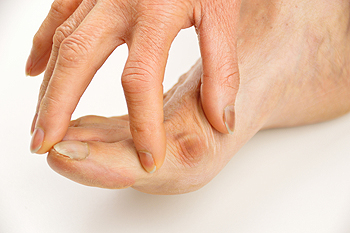
Many people who have bunions are concerned that it is a cosmetic condition. There are some patients who are aware they may cause pain, and this can hinder completing daily activities. The medical term for a bunion is referred to as hallux valgus, and it is defined as a bony lump on the side of the big toe. It gradually develops from genetic reasons, or from wearing shoes that do not have enough room for the toes to move freely in. It will begin as a small bump, and will gradually increase in size if the same type of shoes are frequently worn. It can affect the other toes by pushing against them, and this can cause them to shift. Some patients develop corns and calluses on top of the shifted toes, and bursitis can develop in the affected joint of the big toe. There are protective pads that can be worn over the bunion until larger shoes are purchased. If you see the first sign of a bunion, or if it has increased in size, it is strongly advised that you are under the care of a podiatrist who can possibly recommend surgery for permanent relief.
If you are suffering from bunion pain, contact one of our podiatrists of Foot & Ankle Associates of Maine. Our doctors can provide the care you need to keep you pain-free and on your feet.
What Is a Bunion?
Bunions are painful bony bumps that usually develop on the inside of the foot at the joint of the big toe. As the deformity increases over time, it may become painful to walk and wear shoes. Women are more likely to exacerbate existing bunions since they often wear tight, narrow shoes that shift their toes together. Bunion pain can be relieved by wearing wider shoes with enough room for the toes.
Causes
- Genetics – some people inherit feet that are more prone to bunion development
- Inflammatory Conditions - rheumatoid arthritis and polio may cause bunion development
Symptoms
- Redness and inflammation
- Pain and tenderness
- Callus or corns on the bump
- Restricted motion in the big toe
In order to diagnose your bunion, your podiatrist may ask about your medical history, symptoms, and general health. Your doctor might also order an x-ray to take a closer look at your feet. Nonsurgical treatment options include orthotics, padding, icing, changes in footwear, and medication. If nonsurgical treatments don’t alleviate your bunion pain, surgery may be necessary.
If you have any questions, please feel free to contact our office located in Brunswick, ME . We offer the newest diagnostic and treatment technologies for all your foot care needs.
